Chapter 1 Lecture Nerve Cells and Impulses
Modified: 2023-08-31 1:19 PM CDST
We will start from the bottom of the nervous system, that is we'll start by looking at neurons and other building blocks of the system. This chapter covers one part of the puzzle, the part INSIDE the neuron. The next chapter will cover what happens BETWEEN neurons.
MODULE 1.1
Neurons and Glia
-
The human nervous system comprises two kinds of cells
-
Neurons: my grad school instructor was disappointed after he disected his first brain. All he had left was a pile of mush, neurons, glia, and other cells. The brain has no hidden organs like the body does (heart, stomach, liver, etc.). It's the organization of those billions of neurons that makes the difference. The number of neurons per person varies but it is around 86 billion
-
Glia: several types and serve different functions: astrocytes, microglia, oligodendrocytes, Schwann cells, and radial glia
-
Number of neurons: LOTS 86 billion (just an estimate). Cortex: 16B, Cerebellum: 69B, Rest of Brain: <1B, Spinal Cord: 1B
The Structures of an Animal Cell
Like other cells in the body, neurons contain the following structures and have their own distinctive shape: (p. 20, neurons stained to appear dark)

-
Membrane: separates the inside of the cell from the outside environment
-
Nucleus: contains the chromosomes
-
Mitochondria: performs metabolic activities and provides energy that the cells requires
-
Ribosomes: sites at which the cell synthesizes new protein molecules
-
Endoplasmic reticulum: network of thin tubes that transports newly synthesized proteins to their location
Motor and Sensory Neurons (p. 20)
-
A motor neuron
-
Has its soma in the spinal cord
-
Receives excitation from other neurons
-
Conducts impulses along its axon to a muscle or gland.
-
Has myelin sheath (see saltatory conduction below)
-
A sensory neuron
-
Is specialized at one end to be highly sensitive to a particular type of stimulation (touch, light, sound, etc.)
A Vertebrate Motor Neuron
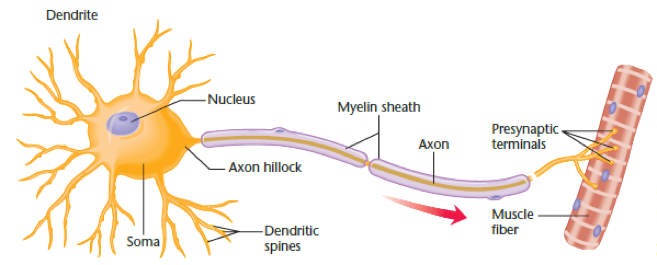
A Vertebrate Sensory Neuron (we'll discuss Sensation and Perception later in the course.

Components of All Neurons
-
Dendrites: Branching fibers with a surface lined with synaptic receptors responsible for bringing information into the neuron. Some also contain dendritic spines that further branch out and increase the surface area of the dendrite. The greater the surface area of the dendrite, the more information it can receive
-
Soma/cell body: Contains the nucleus, mitochondria, and ribosomes. Responsible for the metabolic work of the neuron. Covered with synapses on its surface in many neurons
-
Axon:Thin fiber of a neuron responsible for transmitting nerve impulses toward other neurons, organs, or muscles. May have a myelin sheath, an insulating material that contains interruptions in the sheath known as nodes of Ranvier.
-
Presynaptic terminals: Presynaptic terminals at the end points of an axon release chemicals to communicate with other neurons
Afferent, Efferent, and Intrinsic
-
Afferent axon: refers to bringing information into a structure (one-way highway INTO the CNS)
-
Efferent axon: refers to carrying information away from a structure (one-way highway FROM the CNS)
-
Interneurons or intrinsic neurons are those whose dendrites and axons are completely contained within a single structure (e.g., the thalamus, p. 21)
Variations Among Neurons
-
Neurons vary in size, shape, and function
-
The shape of a neuron determines it connection with other neurons and its contribution to the nervous system
-
The function is closely related to the shape of a neuron
-
Example: Purkinje cells of the cerebellum branch extremely widely within a single plane
The Diverse Shape of Neurons
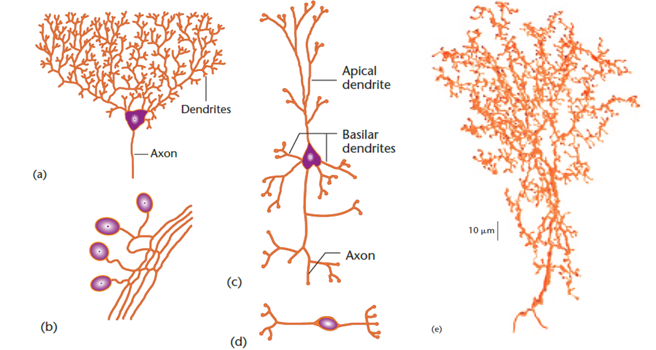
a) Purkinje cell (only found in cerebellum), b) sensory neurons from skin to spinal cord, c) pyramidal cell of motor area of the cerebral cortex, d) bipolar cell of retina of the eye, e) Kenyon cell from a honeybee (p. 22)
Types of Glia
-
Astrocytes
-
Help synchronize the activity of the axon by wrapping around the presynaptic terminal and taking up chemicals released by the axon
-
Responsible for dilating blood vessels to bring more nutrients into brain areas with heightened activity
-
Microglia
-
Remove waste material, viruses, and fungi from the brain
-
Also remove dead, dying, or damaged neurons
-
Oligodendrocytes (in the brain and spinal cord) and Schwann cells (in the periphery of the body)
-
Build the myelin sheath that surrounds and insulates certain vertebrate axons
-
Radial glia
-
Guide the migration of neurons and the growth of their axons and dendrites during embryonic development
(When embryonic development finishes, most radial glia differentiate into neurons and a smaller number differentiate into astrocytes and oligodendrocytes.)
Shapes of Various Glia Cells (see page 23 for caption)
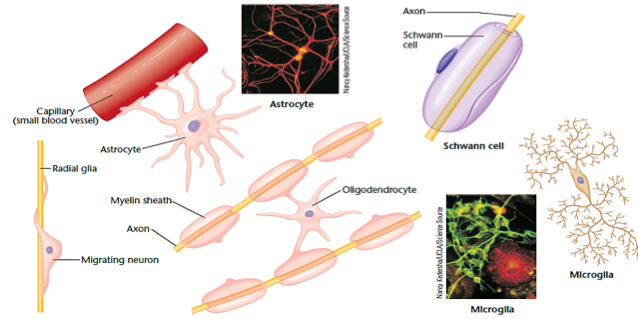
The Blood-Brain Barrier
-
A mechanism that surrounds the brain and blocks most chemicals from entering
-
The immune system destroys damaged or infected cells throughout the body
-
Because neurons in the brain generally do not regenerate, it is vitally important for the blood brain barrier to block incoming viruses, bacteria, or other harmful material from entering
-
Most viruses fail to penetrate blood-brain barrier but some can: chicken pox and shingles; genital herpes
-
Glucose and blood-brain barrier
How the Blood-Brain Barrier Works (see p. 24 for caption)

-
Active Transport
-
The protein-mediated process that expends energy to pump chemicals from the blood into the brain
-
Glucose, certain hormones, amino acids, and a few vitamins are brought into the brain via active transport
-
The blood-brain barrier is essential to health, but can pose a difficulty in allowing chemicals such as chemotherapy for brain cancer to pass the barrier
Nourishment of Vertebrate Neurons
-
Vertebrate neurons depend almost entirely on glucose
-
That sugar that is one of the few nutrients that can pass through the blood-brain barrier
-
Neurons need a steady supply of oxygen
-
20 percent of all oxygen consumed by the body is used by the brain (if your body sent you an itemized bill for oxygen use, the brain would use the most)
-
The body needs a vitamin, thiamine, to use glucose
-
Prolonged thiamine deficiency leads to death of neurons as seen in Korsakoff’s syndrome, a result of chronic alcoholism
-
MODULE 1.2
The Nerve Impulse
-
The electrical message that is transmitted down the axon of a neuron
-
Does not travel directly down the axon, but is regenerated at points along the axon so that it is not weakened
-
The speed of nerve impulses ranges from less than 1 meter/second to 100 meters/second
-
A touch on the shoulder reaches the brain more quickly than a touch on the foot
-
Neural conduction velocity is major factor in all behavior and cannot be made faster (a biological limit) (an analog is the transmission delay when watching live news on TV. Anchor and correspondent must wait for sound to travel a long distance. So, back to the body, a larger animal's neurons may have to travel further, and thus take longer to arrive.)
-
The brain is not set up to register small differences in the time of arrival of touch messages
-
However, in vision, movements must be detected as accurately as possible (we'll discuss further in Vision chapter)
-
The properties of impulse control are well adapted to the exact needs for information transfer in the nervous system
The Resting Potential of the Neuron
-
Messages in a neuron develop from disturbances of the resting potential
-
At rest, the membrane maintains an electrical gradient known as polarization
-
A difference in the electrical charge inside and outside of the cell (think of a car battery. its two poles (anode and cathode) are polarized. But (and don't ever do this!), if you contact both poles at the same time with a conductor such as a wrench, the battery will depolarize. Electricity, at 12 volts, is now being conducted from one pole to the other and sparks will fly!
-
The inside of the membrane is slightly more negative with respect to the outside (approximately -70 millivolts)
-
The resting potential of a neuron refers to the state of the neuron prior to the sending of a nerve impulse
The Membrane of a Neuron
-
Forces Acting on Sodium and Potassium Ions
-
The membrane is selectively permeable, allowing some chemicals to pass more freely than others
-
Sodium, potassium, calcium, and chloride pass through channels in the membrane
-
When the membrane is at rest:
-
Sodium channels are closed
-
Potassium channels are partially closed allowing the slow passage of potassium
Ion Channels in the Membrane of a Neuron (p. 29)
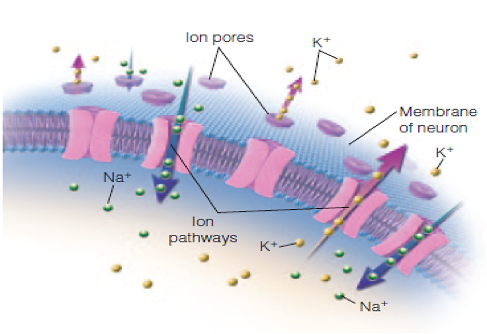
Ion Channels
-
The sodium-potassium pump is a protein complex
-
Continually pumps three sodium ions out of the cells while drawing two potassium ions into the cell
-
Helps to maintain the electrical gradient
-
Uses active transport (requires ATP)
Electrical and Concentration Gradients
-
The electrical gradient and the concentration gradient—the difference in distributions of ions—work to pull sodium ions into the cell
-
The electrical gradient tends to pull potassium ions into the cells
-
However, they slowly leak out, carrying a positive charge with them
Sodium and Potassium Gradients for a Resting Membrane (p. 30)
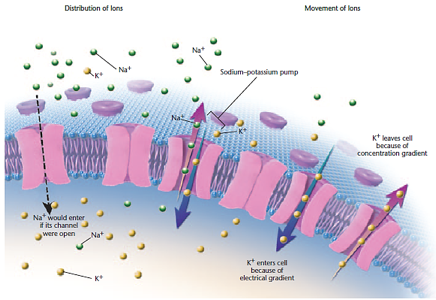
The Action Potential
-
The resting potential remains stable until the neuron is stimulated
-
Hyperpolarization: increasing the polarization or the difference between the electrical charge of two places (no action potential)
-
Depolarization: decreasing the polarization toward zero
-
The threshold of excitation: a level above which any stimulation produces a massive depolarization (also see All or None Law below). Action potential only occurs when threshold is reached or exceeded.
-
A rapid depolarization of the neuron
-
The action potential threshold varies from one neuron to another, but is consistent for each neuron
-
Stimulation of the neuron past the threshold of excitation triggers a nerve impulse or action potential.
-
A neuron artificially stimulated in the middle of the axon will send action potential in both directions (so, it's the organization of the nervous system, not the axon, that determines direction of action potential)
Analogy: A string of firecrackers is a good analogy for the action potential. From a distance, the explosions look continuous, but in reality the explosions are a series of discrete events.
Voltage-Activated Channels
Membrane channels whose permeability depends upon the voltage difference across the membrane
Sodium and potassium channels
When sodium channels are opened, positively charged sodium ions rush in and a subsequent nerve impulse occurs
The Movement of Sodium and Potassium Ions During an Action Potential (p. 33) (imagine a series of these traveling down the axon, one after the other)
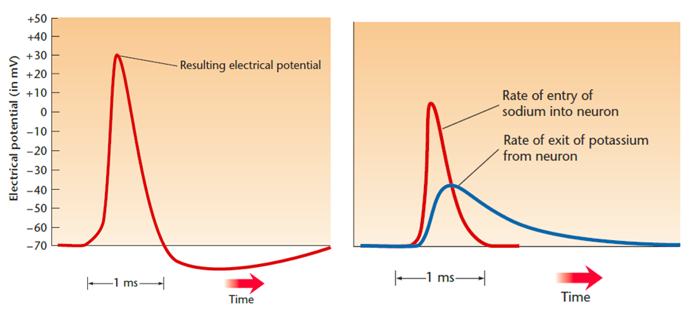
The Movement of Sodium and Potassium
-
After an action potential occurs, sodium channels are quickly closed
-
The neuron is returned to its resting state by the opening of potassium channels
-
Potassium ions flow out due to the concentration gradient and take with them their positive charge
-
The sodium-potassium pump later restores the original distribution of ions
Restoring the Sodium-Potassium Pump
-
The process of restoring the sodium-potassium pump to its original distribution of ions takes time
-
An unusually rapid series of action potentials can lead to a buildup of sodium within the axon
-
Can be toxic to a cell, but only in rare instances such as stroke and after the use of certain drugs
Blocking Sodium Channels
-
Local anesthetic drugs block sodium channels and therefore prevent action potentials from occurring
-
Example: Novocain and Xylocaine
The All-or-None Law
-
The all-or-none law
-
States that the amplitude and velocity of an action potential are independent of the intensity of the stimulus that initiated it
-
Action potentials are equal in intensity and speed within a given neuron
-
Think of a standard toilet: hit the handle get one flush (full tank, get same flush)
-
A neuron can only fire in one way
-
It cannot give a graded signal
-
-
In that cartoon Dennis's dad is carrying him home, and Dennis says: "Of course I heard you, you just did not seem mad enough yet."
-
(If anyone finds that cartoon let me know! I spent two hours looking for it last night!)
-
Obviously, Dennis's dad had been calling him: Dennis, Dennis, DENNIS!
-
He was using a graded signal
-
Neurons cannot do that. They can only change their rate of firing. Let me substitute the letter "D" for "Dennis" and look at a neuron
-
Here is the early signal D----------D----------D----------D----------D
-
Here is a later signal D-----D-----D-----D-----D-----D-----D
-
Here is the last signal D--D--D--D--D--D--D--D--D--D--D
-
The neuron changes its rate of firing and, thus, changes the information it is relaying
-
Note that because of the refractory period (see below) the neuron cannot fire without some delay between each action potential
-
Action potentials vary from one neuron to another in terms of amplitude, velocity, and shape
Refractory Periods
-
In physiology, refractory means not responding
-
After a neuron fires it cannot fire again for a short period of time, that is its refractory period
-
There are two refractory periods in the neuron
-
Absolute Refractory Period where no stimulus can make the neuron fire again
-
Relative Refractory Period where, following the Absolute Refractory Period STRONGER than normal stimulation can make the neuron fire again, sooner than normal
-

-
My metaphor is the "magic toilet"
-
imagine a toilet that always gives you a full flush even when its tank is not full
-
a real toilet cannot do that even if you hit the handle harder
-
a magic toilet will flush fully at some point in its filling if you hit the handle harder
In physiology, refractory means not responding
-
After a neuron fires it cannot fire again for a short period of time, that is its refractory period
-
There are two refractory periods in the neuron
-
Absolute Refractory Period where no stimulus can make the neuron fire again
-
Relative Refractory Period where, following the Absolute Refractory Period STRONGER than normal stimulation can make the neuron fire again, sooner than normal
-
My metaphor is the "magic toilet"
-
imagine a toilet that always gives you a full flush even when its tank is not full
-
a real toilet cannot do that even if you hit the handle harder
-
a magic toilet will flush fully at some point in its filling if you hit the handle harder a real toilet will not
-
but, a "half full" neuron will fire fully when more strongly stimulated during the relative refractory period
-
see the Integration: All or none and summation link below for more details
After an action potential, a neuron has a refractory period during which time the neuron resists the production of another action potential
-
The absolute refractory period: the first part of the period in which the membrane cannot produce an action potential
-
The relative refractory period: the second part, in which it takes a stronger than usual stimulus to trigger an action potential
Propagation of an Action Potential
In a motor neuron, the action potential begins at the axon hillock (a swelling where the axon exits the soma)
Propagation of the action potential: the transmission of the action potential down the axon
The action potential does not directly travel down the axon
The Myelin Sheath
-
The myelin sheath of axons are interrupted by short unmyelinated sections called nodes of Ranvier
-
Myelin is an insulating material composed of fats and proteins
-
At each node of Ranvier, the action potential is regenerated by a chain of positively charged ions pushed along by the previous segment
An Axon Surrounded by a Myelin Sheath (p. 35)
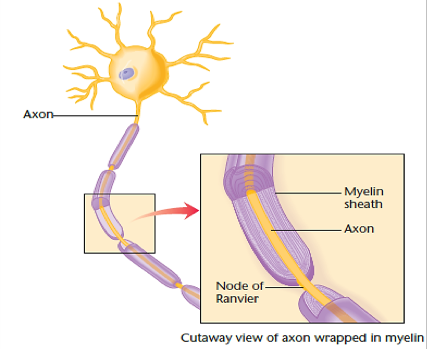
Saltatory Conduction
-
The “jumping” of the action potential from node to node (Latin: saltare = "to jump" in English)
-
Provides faster conduction of impulses than unmyelinated axon
-
Conserves energy for the cell
-
Multiple sclerosis: disease in which the myelin sheath is destroyed
-
Associated with poor muscle coordination and sometimes visual impairments
Saltatory Conduction in a Myelinated Axon (p. 35) (short video)
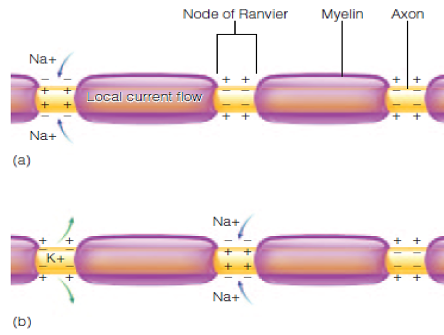
Local Neurons
-
Have short axons, exchange information with only close neighbors, and do not produce action potentials
-
When stimulated, produce graded potentials—membrane potentials that vary in magnitude and do not follow the all-or-none law
-
Depolarize or hyperpolarize in proportion to the stimulation
-
Difficult to study due to their small size
-
Most of our knowledge has come from the study of large neurons
Myth
Only 10 percent of neurons are active at any given moment
Truth
You use all of your brain, even at times when you might not be using it very well
Back to Main Page












